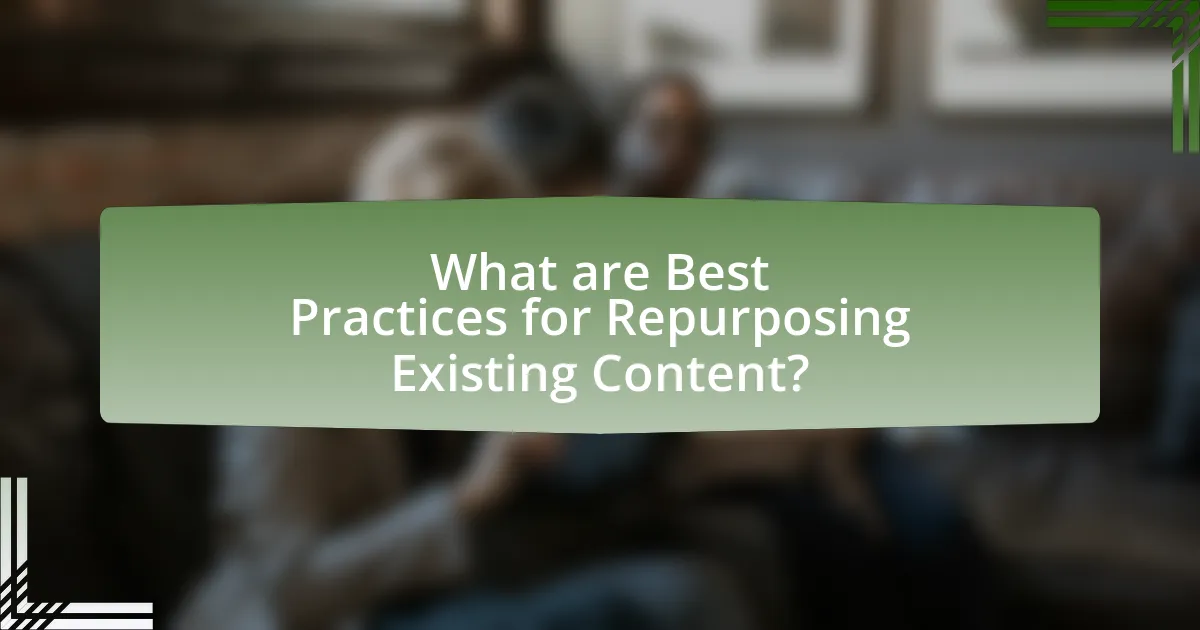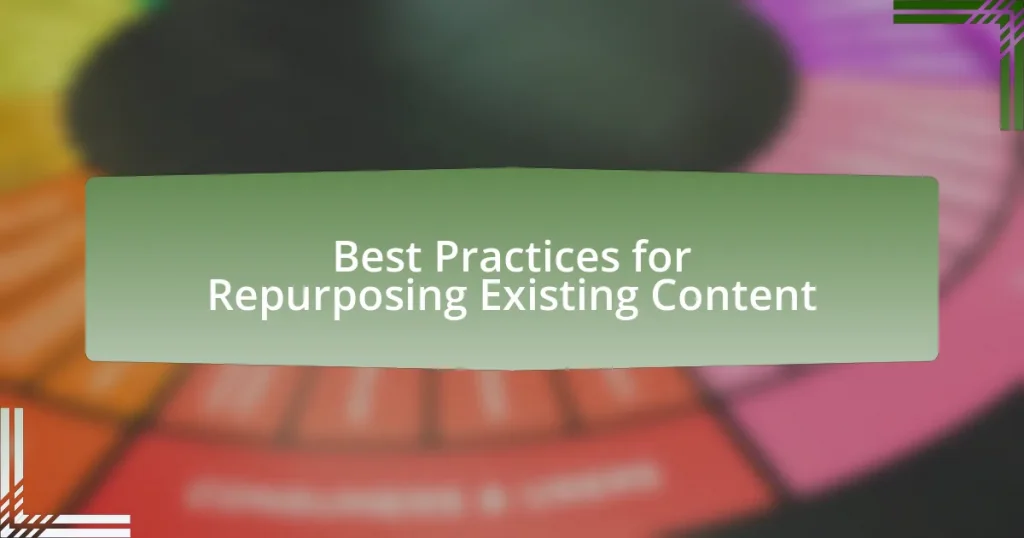The article focuses on best practices for repurposing existing content, emphasizing the importance of maximizing the value of high-performing assets while reaching diverse audiences across various platforms. Key strategies include identifying successful content, adapting it into different formats such as videos, infographics, and podcasts, and updating information to maintain relevance. The article also highlights the time and resource efficiency gained through repurposing, the impact on audience engagement, and the types of content suitable for transformation. Additionally, it discusses effective methods for measuring the success of repurposed content and common pitfalls to avoid, ensuring marketers can enhance their content strategies effectively.

What are Best Practices for Repurposing Existing Content?
Best practices for repurposing existing content include identifying high-performing content, adapting it for different formats, and updating it with current information. High-performing content, such as blog posts that received significant engagement, can be transformed into videos, infographics, or podcasts to reach diverse audiences. Adapting content ensures that it resonates with different platforms; for example, a detailed article can be summarized into a social media post. Updating content with the latest data or trends enhances its relevance and value, as evidenced by studies showing that refreshed content can improve search engine rankings and user engagement.
Why is repurposing content important for marketers?
Repurposing content is important for marketers because it maximizes the value of existing assets while reaching diverse audiences across various platforms. By transforming a single piece of content into multiple formats—such as turning a blog post into a video or an infographic—marketers can enhance engagement and extend the lifespan of their messages. Research indicates that 60% of marketers find repurposing content to be an effective strategy for increasing brand visibility and driving traffic, as it allows them to cater to different consumer preferences and consumption habits.
How does repurposing content save time and resources?
Repurposing content saves time and resources by allowing creators to leverage existing materials for new formats or audiences, thus reducing the need for original content creation. This practice streamlines the content production process, as it eliminates the time spent on brainstorming and developing entirely new ideas. For instance, a single blog post can be transformed into a video, infographic, or social media posts, maximizing the value of the initial effort. Additionally, studies show that repurposing can lead to increased engagement; for example, content that is adapted for different platforms can reach diverse audiences, enhancing overall visibility without incurring significant additional costs.
What impact does repurposing have on audience engagement?
Repurposing content significantly enhances audience engagement by providing diverse formats that cater to different preferences. When content is transformed into various formats, such as videos, infographics, or podcasts, it reaches a broader audience and increases the likelihood of interaction. For instance, a study by HubSpot found that companies that repurpose content see a 60% increase in engagement rates, as they effectively capture the attention of users who may prefer one format over another. This strategy not only maximizes the value of existing content but also fosters a deeper connection with the audience, leading to higher retention and interaction levels.
What types of content can be repurposed?
Various types of content can be repurposed, including blog posts, videos, podcasts, infographics, social media posts, and webinars. For instance, a blog post can be transformed into a video script, while a podcast episode can be transcribed into an article. This practice not only maximizes the value of existing content but also caters to different audience preferences. Research indicates that repurposing content can increase reach and engagement, as it allows for the same information to be presented in multiple formats, thus appealing to diverse learning styles and consumption habits.
How can blog posts be transformed into other formats?
Blog posts can be transformed into other formats by repurposing their content into various media types such as videos, infographics, podcasts, eBooks, and social media posts. For instance, a blog post can be summarized into a video script, allowing for visual storytelling that engages audiences differently. Additionally, key points from the blog can be designed into an infographic, which presents information visually and is easily shareable. Podcasts can be created by discussing the blog’s themes, providing an audio format for those who prefer listening. eBooks can compile multiple blog posts on a related topic, offering a comprehensive resource. Social media posts can highlight quotes or tips from the blog, driving traffic back to the original content. These transformations not only extend the reach of the content but also cater to diverse audience preferences, enhancing engagement and visibility.
What are effective ways to repurpose videos?
Effective ways to repurpose videos include creating shorter clips for social media, transforming video content into blog posts, and converting videos into podcasts. Shorter clips can capture attention quickly on platforms like Instagram or TikTok, increasing engagement. Blog posts can summarize key points from the video, providing additional context and improving SEO. Converting videos into podcasts allows the content to reach audiences who prefer audio formats, expanding the content’s reach. These methods leverage existing video content to maximize its utility and audience engagement.
What strategies should be followed for effective content repurposing?
Effective content repurposing strategies include identifying high-performing content, adapting it for different formats, and targeting diverse audiences. First, analyzing metrics such as engagement rates and shares helps pinpoint content that resonates well with the audience. For instance, a blog post that garners significant traffic can be transformed into a video, infographic, or podcast episode, thus reaching users who prefer different content types. Additionally, tailoring the repurposed content to suit various platforms—like creating shorter snippets for social media or detailed guides for email newsletters—ensures broader audience engagement. This approach not only maximizes the value of existing content but also enhances brand visibility across multiple channels.
How can you identify high-performing content for repurposing?
To identify high-performing content for repurposing, analyze metrics such as engagement rates, shares, and conversion rates. High-performing content typically exhibits strong audience interaction, indicated by metrics like a minimum of 1,000 shares or a 5% engagement rate, which suggests that the content resonates well with the target audience. Additionally, tools like Google Analytics can provide insights into page views and time spent on the page, helping to pinpoint content that captures attention effectively. By focusing on these quantifiable metrics, you can systematically determine which pieces of content are most valuable for repurposing efforts.
What tools can assist in the repurposing process?
Tools that can assist in the repurposing process include content management systems, graphic design software, and social media scheduling tools. Content management systems like WordPress enable users to easily update and modify existing content for different formats. Graphic design software such as Canva allows for the creation of visually appealing graphics from written content, enhancing engagement. Social media scheduling tools like Hootsuite facilitate the distribution of repurposed content across various platforms, maximizing reach and visibility. These tools streamline the repurposing process, making it efficient and effective.
How can you measure the success of repurposed content?
You can measure the success of repurposed content by analyzing key performance indicators (KPIs) such as engagement rates, traffic metrics, and conversion rates. Engagement rates can be assessed through likes, shares, comments, and time spent on the content, indicating how well the audience interacts with the repurposed material. Traffic metrics, including page views and unique visitors, help determine the reach of the content across different platforms. Conversion rates, which track actions taken by users such as sign-ups or purchases, provide insight into the effectiveness of the content in driving desired outcomes. According to a study by HubSpot, content that is repurposed can lead to a 75% increase in engagement, demonstrating the potential impact of effective repurposing strategies.
What metrics should be tracked to evaluate performance?
Key metrics to track for evaluating performance in repurposing existing content include engagement rate, conversion rate, reach, and return on investment (ROI). Engagement rate measures how well the content resonates with the audience, typically assessed through likes, shares, comments, and time spent on the page. Conversion rate indicates the percentage of users who take a desired action, such as signing up for a newsletter or making a purchase, directly linked to the effectiveness of the content. Reach quantifies the total number of unique users who view the content, providing insight into its visibility and audience size. ROI evaluates the financial return generated from the content relative to the costs incurred in its creation and promotion, ensuring that resources are allocated efficiently. Tracking these metrics allows for a comprehensive understanding of content performance and informs future content strategies.
How can audience feedback inform future repurposing efforts?
Audience feedback can significantly inform future repurposing efforts by providing insights into what content resonates most with the audience. Analyzing feedback, such as comments, ratings, and engagement metrics, allows content creators to identify popular themes, formats, and topics that engage their audience effectively. For instance, a study by HubSpot found that 70% of marketers reported that audience feedback directly influenced their content strategy, leading to more targeted and relevant repurposing initiatives. This data underscores the importance of leveraging audience insights to enhance the effectiveness of content repurposing.
What common mistakes should be avoided when repurposing content?
Common mistakes to avoid when repurposing content include failing to tailor the content for the new audience, neglecting to update outdated information, and not optimizing for different formats. Tailoring content ensures relevance; for instance, a blog post may need to be adjusted for a video format to engage viewers effectively. Updating outdated information is crucial, as statistics or references that are no longer accurate can mislead the audience. Additionally, optimizing for different formats, such as adjusting the length and style for social media versus a detailed article, enhances user experience and engagement.
How can over-repurposing negatively impact brand perception?
Over-repurposing can negatively impact brand perception by creating a sense of redundancy and diminishing originality. When a brand excessively reuses the same content across various platforms, it risks appearing uninspired and disengaged, which can lead to audience fatigue. Research indicates that 60% of consumers feel frustrated when they encounter repetitive content, which can erode trust and loyalty towards the brand. This perception of lack of innovation can ultimately result in decreased engagement and a tarnished brand image.
What are the risks of not updating repurposed content?
Not updating repurposed content can lead to misinformation, decreased audience engagement, and diminished SEO performance. Misinformation arises when outdated facts or statistics are presented, potentially damaging credibility and trust with the audience. Decreased engagement occurs as audiences may find the content irrelevant or unhelpful, leading to lower interaction rates. Additionally, search engines prioritize fresh and relevant content; thus, failing to update can result in lower rankings and visibility. According to a study by HubSpot, 61% of marketers say improving SEO and growing their organic presence is their top inbound marketing priority, highlighting the importance of keeping content current for optimal performance.
What are some practical tips for successful content repurposing?
Successful content repurposing involves adapting existing content into different formats to reach new audiences and extend its lifespan. To achieve this, identify high-performing content that resonates with your audience, such as blog posts or videos, and transform it into various formats like infographics, podcasts, or social media posts. Additionally, tailor the repurposed content to suit the platform’s audience and format requirements, ensuring it remains engaging and relevant. For instance, a detailed blog post can be summarized into a series of tweets or a video tutorial, maximizing its reach and impact. This approach not only saves time but also enhances content visibility and engagement across multiple channels.




